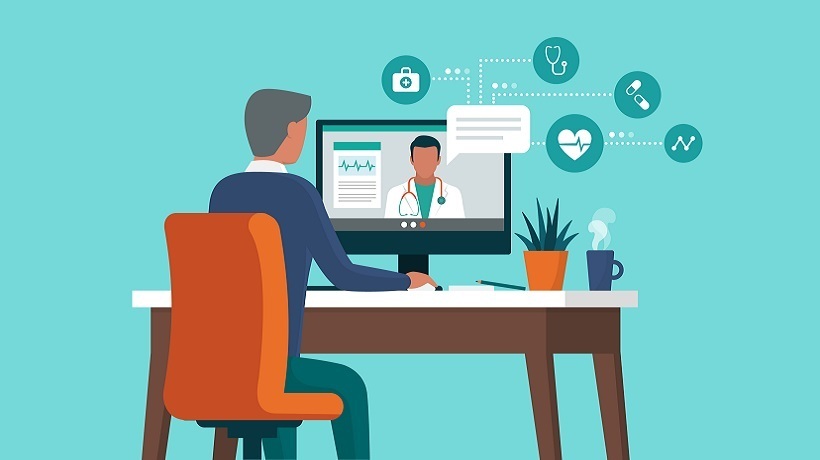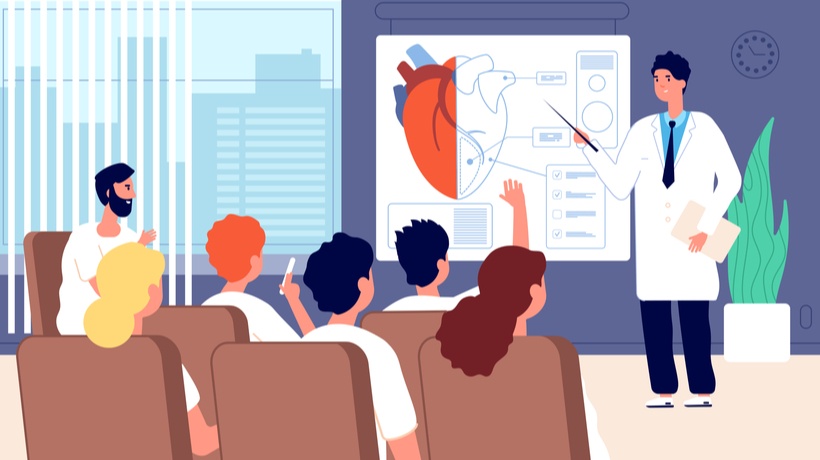eLearning And Telehealth
With the emergence of COVID-19 in 2020, every area of society was pushed to reinvent, reorder, and restructure, including healthcare. COVID-19 had a significant impact on medical institutions all over the world. Medical institutions have been forced to offer robust, easily accessible virtual education choices in response to concerns about the spread of the infection, which has greatly aided the development of new, creative remedies.
Telehealth and eLearning were the solution to the entire problem. For decades, government-funded programs have provided telephonic healthcare to remote locations on the ground and in the air. The COVID-19 pandemic and the global shutdown that followed set a solid framework for the later successful development of telemedicine. Technological innovations have established new standards in various industries, including healthcare. Over the past few decades, healthcare has seen a considerable shift attributed to cutting-edge technologies like remote patient monitoring (RPM) and telehealth. RPM and telehealth have worked together to overcome healthcare limitations and provide the greatest healthcare delivery possible at all times.
Telehealth Today
The most promising sector of healthcare and eLearning today is telehealth. According to telemedicine statistics, the usage of virtual care has increased 38 times since the COVID-19 epidemic, and both patients and providers are satisfied with their experiences. Another study conducted among clinicians in the United States and the United Kingdom in 2021 found that 76% felt telehealth would account for most patient treatment in the near future. However, 68% reported having frequent problems delivering telehealth to patients.
Telehealth is a popular alternative for meeting the demands of both healthcare professionals and patients. Some of the most common applications of telemedicine today include administration and remote patient care, which includes teleconsultations, telemonitoring, and telesurgery. Tele-mental wellness is another trend that is gaining traction these days. The technology opens up new possibilities for patients, who may now obtain care from the comfort and safety of their own homes, as well as fantastic chances for mental health specialists.
Telehealth Innovations In Health Education
The mobile app market is brimming with fresh options for healthcare practitioners. These solutions' objectives and target audiences vary, ranging from professional certification and recertification apps to continuing medical education platforms. Nevertheless, they are increasingly helpful for graduate and postgraduate healthcare professional education.
Innovative institutions can now educate on anything, at anytime, from anywhere, by utilizing the immense potential of telehealth in telelearning, telementoring, telesurgical planning environments, telerobotic surgery, and teleconsultation. Additionally, the curriculum and mentoring are of the same caliber as in traditional classroom settings, placing more emphasis on skill mastery than knowledge mastery.
Telehealth And eLearning For Promoting Rural Workforce Education And Training
According to data, in 2015, 28% of people in the EU-28 resided in rural areas. According to research, people who live in rural areas have distinct healthcare demands from those who live in urban areas, and access to healthcare is frequently a problem in these locations. Rural isolation and problems with economic and educational inequality make it difficult to attract and keep skilled workers in these regions.
Even though the rural population is declining, telehealth technology is still valuable to them. Telehealth can support the rural health workforce in overcoming obstacles to education and training, while enabling clinicians to adapt to patients' changing requirements. Instead of traveling for continuing education, rural providers can use telehealth technologies, such as Augmented Reality (AR)/Virtual Reality (VR)-based solutions, to get face-to-face training and showcase skills gained through distance learning.
Many distance education courses use telehealth technology within their curriculum. To improve their ability to handle complex cases, providers in rural locations can receive telementoring from experts abroad. In order to learn occupational therapy and obtain their doctorates, medical students from Creighton University in Omaha, Nebraska, and the University of Alaska-Anchorage have already taken advantage of a novel hybrid online education program. The program includes online courses and video conferencing tools, and clinical adjunct professors in Alaska serve as field mentors and support the Nebraska faculty by teaching the program's lab and experiential components.
Telehealth And eLearning For Connecting Geographically Separated Specialists
Additionally, telemedicine can be applied in a unique setting where geographically separated surgical students can work together to learn, communicate with experts, and even plan surgery. This method can be made more immersive by including Augmented Reality, enabling surgeons and their staff to watch a 3D monitor while performing surgery. Doctors and even surgeons can operate on patients thousands of kilometers distant by using video conferencing. This makes it possible for medical teams from different continents to communicate and organize video conferences to discuss difficult and critical cases. Videos cannot replace the need for intensive tutor-student interaction in surgical skills instruction. In order to improve communication among surgeons, the University of Hong Kong created a new web-based surgical skill learning session (WSSL).
Why eLearning For Telemedicine?
eLearning allows for learning anytime, anywhere. Because healthcare and medical workers frequently work long hours over many shifts, eLearning can allow learners to fit training around their schedules. If the practitioner wants to return to a particular portion, eLearning can serve as always-available reference information.
The velocity of development in the telemedicine industry is another crucial factor. Telemedicine technology is always evolving and improving, which unavoidably leads to best practices and legislation modifications. Content updates are quick, simple, and generally inexpensive when training healthcare professionals online. As a result, one can stay up to date on advancements far more quickly than in face-to-face or paper-based training.
Basics Of Remote Patient Monitoring
The market share of remote patient monitoring devices in 2021 was $1.45 billion and will reach $4.07 billion by 2030, at an 8.74% CAGR. RPM enables practitioners to monitor patients between clinic visits, or when in-person therapy is impractical for treating acute and chronic diseases.
RPM allows clinicians to monitor patients in real time, collect the necessary data, and improve care outcomes, which is especially useful for chronic care. This form of continuous surveillance is beneficial for individuals who require ongoing care, such as those with diabetes, heart disease, asthma, hypertension, mental illness, and, more recently, long COVID, which refers to the symptoms that persist after COVID-19 infection and recovery.
Weight scales, pulse oximeters, blood pressure monitors, blood glucose meters, heart monitors, and even specific monitoring for dementia and Parkinson's disease are used in RPM programs. Wearables are another RPM device that can track patients' health over time. Smartwatches and continuous blood glucose monitors are examples of consumer-facing devices.
However, RPM is not only effective for long-term disease management; it can also be used for more urgent and acute problems. Healthcare organizations are establishing hospital-at-home programs more frequently to allow patients to receive treatment for more serious diseases at home. These programs can offer a wide range of services, including X-rays and echocardiograms for diagnostic purposes, oxygen therapy, and intravenous fluids for treatment, as well as skilled nursing and pharmaceutical services.
Furthermore, remote patient monitoring can track recovery after returning from the hospital. The University of California Los Angeles Health System offers a post-surgery RPM program for patients undergoing heart procedures. As part of the program, patients use devices provided in a kit to provide their care team with biometric data such as heart rate, blood pressure, and blood oxygen levels. The team can track this data to confirm that the patient is recovering as expected.
Conclusion
Key trends in telehealth and eLearning have evolved, and they will continue to impact the future of both technologies. Telemedicine is a critical component of the healthcare revolution. Telehealth will continue to grow and become crucial for communication between medical professionals and patients.
Sources:
- Bridging e-Learning and Telehealth: Real Value for Medical Education and Training
- RPM 101: What Is Remote Patient Monitoring, Its Benefits, and Uses?
- Telemedicine Training – Why eLearning is the Best Way to Prepare Your Team
- Remote Patient Monitoring Devices Market By Product (Vital Sign Monitors, Cardiac Monitors, Respiratory Monitoring Devices, Haematological Monitoring Devices, Anaesthesia Systems Monitoring Devices, Renal Function Monitoring Devices, Telemetry Devices, Multi-parameter Monitors, Others), By End-Use (Hospital-based patients, Home care patients, Ambulatory patients), By Application (Cancer, Diabetes, Sleep Disorder, Weight Management, Fitness Monitoring, Cardiovascular Diseases Bronchitis, Virus, Dehydration, Infections, Hypertension), By Geography, Size, Share, Global Trends, Report Forecast, 2021-2030
- Remote patient monitoring and telehealth: How technology paves way for efficient healthcare delivery









